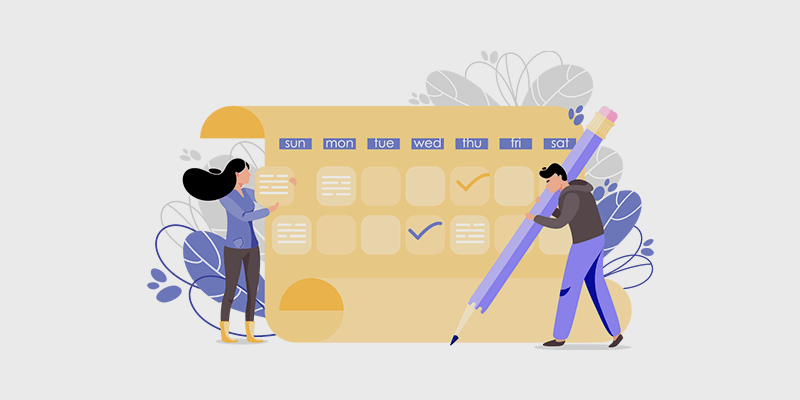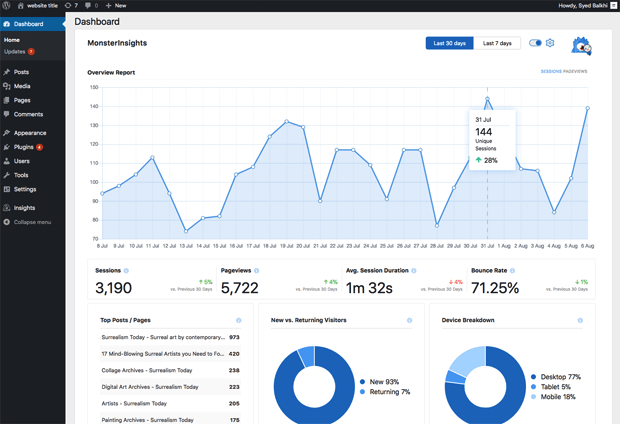
H ow often should you blog? Is there a magic number?
Did you know that millions of new blog posts are published every day? That’s thousands of blog posts published every minute! With all this new content being published daily, it’s totally reasonable to ask yourself, “How often should I blog?”.
But the short answer is… it depends!
The number of posts you publish depends on several factors, including your niche, schedule, topic, blog length, and overall target audience goals.
So, in this article, we’ll share some tips for finding (and maintaining!) your ideal posting frequency for your own blogging goals!
In This Guide:
Ready to figure out how often to blog to get the most traffic and build your audience?
Let’s get started.
How Often Should You Blog?
This is the million-dollar question for any blogger. Do a quick search online, and you’ll find just as many answers. Brian Dean of Backlinko says he gets over 200k unique visitors to his blog every month, and he publishes a new post roughly every 4-6 weeks. On the other hand, some blogs publish multiple posts per day.
So, which blogging frequency is right for you?
Deciding on how often to blog depends on your end goals for your site.
- To increase your traffic, you may want to publish more often since that’ll give search engines more opportunities to find your site and bring visitors to it.
- To increase your income from affiliate marketing on your site, you’ll want to build up more content, like reviews and list posts, since the more content you have, the more opportunities for making sales.
- If you’re blogging about more in-depth topics, you’ll want to publish less frequent but longer-form posts that provide a ton of value to readers.
Some bloggers can write a blog post fast and publish more because they have multiple writers working for them. If you’re the lone writer for your blog, you’ll have to find the happy medium between your schedule and what you’re trying to accomplish with your blog.
So, should you publish one blog post a day, several per week, or just one or two a month? Let’s take a closer look at each schedule and its benefits (and drawbacks).
Publishing One Blog Post a Day: Pros & Cons
Do you like having a writing routine? Would it help you publish more consistently on your blog? Then posting every day might be for you. You’ll build up the habit and be more likely to continue it regularly.
Posting daily is a good schedule for your blog if it’s a news-focused one in a fast-paced niche. Weekly or monthly posts aren’t going to cut it if you want to be a trendsetter with your blog.
Frequent posting is also a good idea if you have a loyal and engaged audience that visits your site regularly. Having fresh new content on a daily basis will encourage them to visit your site as part of their daily routine.
Your blog will also enjoy much love from search engines when you post daily. We’re oversimplifying this idea a bit since even one high ranking post can bring you more traffic than several low ranking ones. But it’s often true that more blog content means more traffic! You can read our blog SEO guide for more details on how it works.
Finally, social media loves blogs with tons of new content, so if social brings you major traffic, you’ll want to post daily. With this posting schedule, people will have tons of high-quality content to share online at all times.
Risks to Posting Daily
According to blogging statistics, only 2% of bloggers have a daily posting frequency. When you post on your blog every day, you run the risk of burning yourself out.
When deciding how often you should post content, consider if writing for your blog will become a chore and something you dread if you blog every day. Add in competing pressures of your personal and family life, and you may not be able to keep up with this level of blog post frequency.
Other times, your blog topic or style simply won’t sustain a daily posting schedule, so your post quality goes down. And readers leave in droves.
Posting a lot of content also means that it’ll be hard to keep it updated and relevant. It can also make your older content harder to find. Few people will look past the first page of your blog to find that nugget of information to share, even if it is better than what’s on the front page!
Tips to Help You Post Every Day
Have you decided to try publishing one blog post a day? Here are a few tips to stick with it:
- Learn how to write faster. If it takes you several hours to write a high-quality blog post, you won’t be able to keep up with a daily schedule.
- Look at the popular blogs in your niche that publish daily and figure out what makes their successful posts work. Then, follow their example, not by copying the content, but by following their structure.
- Vary your post types to keep your readers engaged: try video posts, ones with lots of images, listicles, and more. Some types of blog posts are much faster and easier to create than others.
- Make sure your blog topic or style has enough content for you to write about and keep your readers coming back with this blog frequency. If not, consider changing to a less frequent schedule or broadening your blog niche.
Is blogging daily not for you? Let’s take a look at the pros and cons of publishing less often.
Posting Several Times Per Week… or Month!
Recently, many prominent bloggers have moved away from daily posting and posting less frequently, such as publishing just a few blog posts per week or even just a few posts a month.
Why did they switch? It’s because we’re inundated with so much content today that it’s hard to keep up with that number of blog posts as a reader. In fact, the #1 reason we unsubscribe from a blog is that they publish too often.
As long as you say something useful and valuable when you publish new blog posts, your readers will appreciate your blogging schedule, no matter what it is.
A publishing frequency of once or twice a week, or even once a month, will let you write a little more in-depth about your topic when you update your blog. When determining how often you should blog, it’s been shown that longer posts will get you more shares and links.
Tips to Make the Most of Publishing Less Frequently
- Experiment with longer posts, such as ones 1,000+ words long.
- Focus on creating evergreen content, which ensures each post stays relevant for years.
- Take your time to do keyword research, optimize your posts for SEO, and promote your blog so that you still get the most traffic possible, even with less content.
How to Find Your Ideal Blogging Frequency
As bloggers, we’ve all got different skills and personalities, not to mention unique constraints on our time and energy. Each one of those will dictate how often to blog, so don’t force yourself to stick to someone else’s blogging routine “just because” they say so. It probably won’t work well for you.
Your perfect blogging frequency is a combination of three things: Your ability to write quality content consistently, your blogging goals, and your target audience’s preferences. You can control the first two, but the last one will take some experimenting.
(And if you’re just starting out, you won’t have anyone to ask, but don’t worry, we’ve got you covered, too!)
1. Ask Your Readers
Many top bloggers do a quick blog survey or poll to find out how often they prefer to hear from them. Of course, this only works after your blog’s been up for a while, but it can yield some interesting information!
2. Try Experimenting To Find Your Ideal Blog Frequency
Next up, you can experiment with your blogging frequency to see which works best for you and your readers.
For example, Neil Patel typically published one post per week, but he was curious to see what would happen if he increased it to two posts per week. After a short time, his monthly traffic rose from just over 46k to nearly 60k, and he got it up to over 100k in just under a year.
Want to know how your blogging frequency impacts your own traffic?
You can set up Google Analytics on your blog with MonsterInsights to track it.
Then you’ll be able to see your traffic right from your WordPress dashboard:

You can even get stats on the best time of day to publish!
Key Takeaways For How Often You Should Blog
- Finding the Perfect Balance: Determining the right frequency for blogging is crucial but varies widely based on several factors, including goals, content type, audience needs, and individual or team capacity. There’s no one-size-fits-all answer, but aiming for a balance that meets your objectives without compromising quality or your well-being is key.
- The Pros and Cons of Daily Posting: For those considering daily posts, it offers a routine, satisfies a news-hungry audience, and can boost search engine visibility. However, it’s a demanding schedule that can lead to burnout and potentially dilute content quality.
- The Shift to Less Frequent Posting: Many successful bloggers are posting less often, focusing on quality over quantity. This shift reflects readers’ preferences for more substantial, value-packed content amidst an overwhelming amount of daily information.
- Quality Over Quantity: Regardless of posting frequency, the emphasis should always be on delivering valuable, engaging content. Longer, in-depth posts have been shown to garner more shares and links, suggesting that how much you say is often more impactful than how often you speak.
- Listening and Experimenting: Tailor your blogging strategy by listening to your audience and experimenting with different frequencies. Use tools like surveys and analytics to gauge preferences and measure results. This approach helps identify a publishing rhythm that resonates with your readers while achieving your blogging goals.
- Sustainability is Key: Ultimately, the best blogging frequency is one that you can maintain over the long term. It should align with your ability to produce high-quality content and manage other life commitments. Striking this balance is essential for long-term success and avoiding burnout.
In essence, the journey to finding your ideal blogging frequency is a personal one, shaped by trial, feedback, and refinement. Start with these insights, but adapt as you learn what works best for your unique situation.
Final Thoughts on Your Blog Posting Schedule
Starting a blog is hard work, but so is keeping it going long-term. By publishing valuable content on a schedule that works for you and also satisfies your readers, you’ll make sure your blog is successful for years to come, all without burning yourself out.


The number of post doesn’t matter…content is what matters.